The Big Mac Index is a humorous yet widely used economic indicator that measures the purchasing power parity (PPP) between different currencies. It was created by The Economist magazine in 1986 as a way to make international economics more understandable to readers.
The index is based on the price of a Big Mac burger sold by the fast-food restaurant McDonald’s in different countries. The idea behind the index is that a Big Mac burger is a globally standardized product, so its price should be similar across countries, and any differences in price can be attributed to the exchange rate between the currencies.
The index compares the price of a Big Mac burger in various countries and calculates the exchange rate that would make the burger cost the same in each country. If the actual exchange rate is higher than the calculated exchange rate, then the currency is considered overvalued, and if it is lower, the currency is considered undervalued.
While the Big Mac Index is not a precise economic indicator, it provides a fun and accessible way to understand exchange rates and global economics. It can also serve as a starting point for more in-depth discussions about the complexities of international trade and finance.
To view the latest comparison refer to The Economist – Big Mac Index

